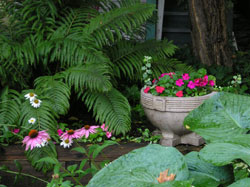Landscapes change over time and require renovation to remain beautiful. One condition that often changes within twenty years of planting a landscape is the degree of shade, due to maturing trees and shrubs. The rest of the garden must change to keep up. While some plants do poorly in shade, many will thrive in these conditions.
The best criterion for landscaping in a shaded spot is to select plants that do well in less light. While some plants thrive in light shade, others will tolerate partial or even full shade. The degree of shade in a landscape may also change with the season. Areas in full sun in the summer may be in partial shade in spring and fall, when the sun is at a lower angle in the sky.
full shade. The degree of shade in a landscape may also change with the season. Areas in full sun in the summer may be in partial shade in spring and fall, when the sun is at a lower angle in the sky.
Available sunlight may sometimes be increased through selective pruning. While large shade trees are a valuable resource, removal of dead, diseased or structurally poor limbs can improve a landscape’s beauty and increase the light available for other plants. Another method to increase light to a landscape is through reflection. Painting a fence or house siding a light color can have a significant effect.
Root competition for moisture is another consideration in shade gardening. Some shade tolerant plants adapt to low moisture situations while others require moist shade. Consider nearby plants, especially trees and shrubs, when choosing and watering plants.
For more information, see the following Colorado State University Extension fact sheet(s).
- Ground Cover Plants
- Small Deciduous Trees
- Large Deciduous Trees
- Pruning Mature Shade Trees
- Xeriscaping: Ground Cover Plants
- Herbaceous Perennials
- Deciduous Shrubs



